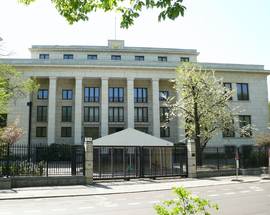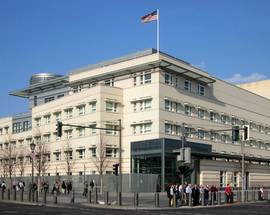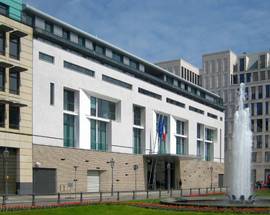Embassy Architecture
more than a year agoThe proximity of nations on Tiergartenstraße and Hirsoshimastraße makes it easy for “countries visited” scorecard-keepers. Most of these home-away-from-home architectural wonders were completed between 1999 and 2003, and their newness hints at a war-torn and torn-city history. In 1937, Albert Speer, the architect responsible for accommodating Hitler’s plans for rebuilding Berlin, ordered embassies to relocate from the area that is now the federal government district to this ‘Diplomatic Quarter’. Jews who lived in the grand mansions here were thrown out, and any embassy wishing to construct a new building was obligated to use a German architect. Bombing destroyed many of the embassies, and when West Germany’s capital moved to Bonn in 1950, surviving ones were abandoned to decay.
The darling of the district is the combined Nordic embassies (www.nordischebotschaften.org), by Berger + Parkinnen, which even have their own bus stop on line 100 (Nordische Botschaften). The Danish, Finnish, Icelandic, Norwegian, and Swedish embassies are uniquely encamped together behind an undulating blue-green patina façade that like a Venetian blind, can wink its horizontal panels to regulate both privacy and light intake. Behind this armor-like barrier you can glimpse the butterscotch-colored aspen used for some of the embassies themselves. To make the place homier, Iceland brought lava rock, and the Norwegians even brought a cosy 14m-high, 120 ton slab of granite. The public entrance to the embassies’ communal Felleshus (‘house for all’) is on Rauchstraße 1. Film nights feature Scandinavian classics, such as Summer with Monika by Ingmar Bergman, and often have English subtitles.
Next door on Klingelhöferstraße 3 is the Mexican embassy. Architect Gonzales de Léon and Seranno has hid the warmth of his country behind a massive concrete and marble entranceway. It invites peeping toms just like the Nordic embassies do, but with slanting supports that create a vertical blind effect. The public exhibition area within a cylinder atrium is in homage to a Mayan observatory, the Americas’ first cylinder construction.
The Egyptian embassy (www.egyptian-embassy.de) on Stauffenberg Straße 6-7 opened in 2003 and though new, wouldn’t look out of place next to the monumental classic architecture in the Pergamon Museum. The façade’s polished brown marble is inscribed with the papyrus plant and the lotus, which represent the two ancient capitals of upper and lower Egypt. The atrium of the embassy may as well be a modern pharaoh’s temple.
Pre-dating World War II are the Japanese and Italian embassies on Hiroshimastraße. Both impressive buildings were completed in 1942 when the two countries were the Axis powers aligned with Nazi Germany.
In the federal government district, the Swiss embassy’s building dates to 1870, and 1910 is the year the diplomats moved in. The building survived World War II bombings not because Switzerland was neutral, but because the caretaker heaved incendiary bombs off the roof with a pitchfork. The Swiss are the only foreign presence on the landscape of the federal chancellery (where Gerhard Schröder works), the parliamentarians’ offices, and the Reichstag. To spot the embassy, just look for the red flag with the white cross piercing a sturdy rooftop.
The allied forces that occupied Berlin have their embassies off prestigious Unter den Linden, all near the Brandenburg Gate. France (www.botschaft-frankreich.de) regained its appropriate position on Pariser Platz in 2003.
Around the corner on Wilhelmstrasse, the British Embassy (www.www.gov.uk) may be the only one to have given its architect the directives ‘fun and openness’. Completed in 2000 by architect Michael Wilford, it sits on the same spot the embassy occupied from 1879-1939. The façade is rather unremarkable except for protruding lilac and sky-blue sectors. The colorful interior is filled with modern art. Terrorism abroad restricts ‘openness’ and the block is shut off to cars and foot traffic. You can join a 45-minute group tour of the embassy by contacting tel. +49 30 20 45 72 73.
The masses-minded Soviet Union indulged itself in a palatial-style embassy in 1953. The building on Unter den Linden 61-65 now serves as the Russian Embassy. The center panel of stained glass depicts the Kremlin, but can only be recognized from the inside. Focus your attention instead on finding the now defunct Soviet hammer and sickle symbol on the friezes.
The United States embassy occupies a new building on Pariser Platz.
The award-winning Rem Koolhaas-designed embassy of The Netherlands (www.sieunddieniederlande.nl) is an eight-story glass building at Rolandufer/Klosterstraße 50. It has no floors, but rather 24 levels linked by a spiralling hall. It overlooks the Dutch-dug Spree canal and locks just south of the Nikolaiviertel. To request a free visit of the entrance hall and a short film screening, send an email well in advance to receptie@bln.nlamb.de, stating your name, date of birth, nationality, passport number, and the day and time that you'd like to visit (10:00, 11:00, 13:30 or 14:30).








Comments